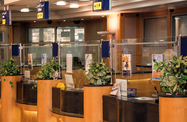Lenders in Bahrain are hoping that the solid rates of growth many banks posted for the first quarter of 2012, coupled with forecasts estimating that the economy should expand between 3.2% and 3.6% this year, mark the beginning of an upward turn for the Kingdom’s banking industry.
Data issued by the Bahrain Association of Banks (BAB) at the beginning of May showed retail banks expanded between 2.5% and 3.5% during that same quarter, prompting some analysts to suggest that lower growth rates recorded after the 2000-08 boom years were now being reversed.
But industry players and analysts are still expected to adopt a cautious approach amid concerns that domestic instability, plus the challenging economic environment, could produce a credit squeeze in the Gulf and impact the roll-out of major projects in Bahrain and across the region.
BAB’s chairman, Abdulkarim Bucheery, told local media in mid-May that a rise in consumer spending has helped boost retail lending, adding that other segments of the sector are also showing signs of rebounding strongly from global economic uncertainty and domestic unrest. “Most of the retail banks have been showing growth,” he said, adding that an expected increase in state and investor outlays could signal new opportunities for the financial institutions.
“There are a number of major projects coming up like the move to link the GCC by a rail network and expansion plans for Bahrain International Airport, and the banking sector looks forward to being involved in active participation in these projects. Things are looking up at the moment and 2012 looks promising,” he said.
This is good news for the Kingdom, as banking is a key driver of the overall economy. Its wide range of financial institutions is a major employer and contributes more than a quarter of the Kingdom’s GDP.
Concerns remain, however, that local unrest and a squeeze on liquidity combined with broader global economic uncertainty could slow domestic recovery, sending a ripple effect across the sector. In a report issued in April, Moody’s Investor Services said the immediate outlook for the industry remained negative, citing the somewhat fragile operating environment of Bahrain’s retail banking sector.
It highlighted the potential for downside risks, saying the domestic asset-quality and profitability metrics of banks could be put under increased pressure. More positively, however, Moody’s added that these risks would be offset by the healthy liquidity and relatively strong capital positions of the Kingdom’s banks.
Bahrain’s banks will also be bracing themselves for fall-out from the deteriorating financial situation in the eurozone, with expectations growing that the crisis will spread further into the global markets.
In an earlier advisory note, released in mid-March, Moody’s warned that Bahraini lenders, along with those in other Gulf states, could face a credit squeeze if European banks cut back on lending to the region to try to strengthen their position at home,. The agency also pointed out that further deleveraging may well coincide with the Gulf states’ plans to increase spending on capital investments.
But, while accepting that the timing of lending cuts from European banks would be unfortunate, many of the country’s bankers remain reasonably upbeat about the sector’s ability to weather fall-out from the eurozone crisis.
Abdullatif Mohamed Janahi, a member of the board of Bahrain-based regional Islamic investment bank Venture Capital Bank (VC Bank), was confident that the institution could build on its first-quarter $8m profit, which it announced on May 15. He cited the International Monetary Fund’s forecast of 3.6% growth and Bahrain’s recovering tourism and financial sectors as key components in the bank’s bid to maintain its performance.
“Given these factors, and our strong financial performance during the first quarter of the year, we remain cautiously optimistic for the Bank’s prospects in 2012,” he said.
Some analysts point out that with the eurozone crisis no nearer resolution, Bahrain could still become caught up in a repeat of the gridlocked bank lending it experienced in 2009.

